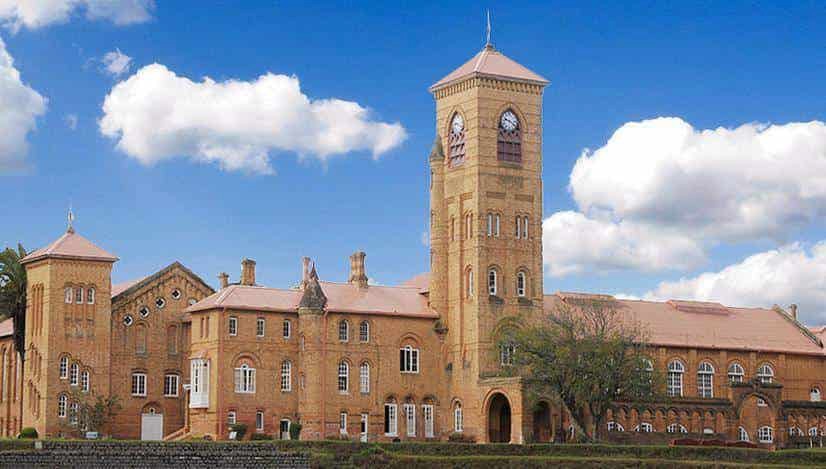THE CHINESE CONVICTS AT LOVEDALE
For most Lawrencians, the only connection between Lovedale and the Chinese has to be with Shinkows the Chinese restaurant which has become a permanent feature in Ooty catering to generations of OLs.
However, today's blog post has nothing to do with Shinkows but is about the Chinese Convicts who were involved in building our school in the 1860s.
In previous posts we have seen how Lovedale was selected as the best location for the expanded Lawrence Asylum in Ootacamund. A student of those times, George Webster has written about the move to Lovedale from Ooty in 1869. You will remember he wrote that over 500 Chinese convicts were busy at work building the new premises for The Lawrence Asylum at Lovedale.
As we saw in a the last post, the buildings- which still stand majestically today- were designed by Robert Chisolm. The construction was carried out by the Chinese convicts with technical and administrative direction from the British officers including those of the Madras Sappers. Now called the Madras Engineer Group, the Madras Sappers date back to 1780 when they were first formed as the Madras Pioneers.
Many of you may know that Lovedale still has the Sappers Line which were probably occupied by these troops many, many years ago.
In case you are wondering how these Chinese convicts reached Lovedale, here's what happened.
The Strait Settlements came under the British East India Company following the Anglo-Dutch Treaty of 1824. Over time they came to be used as penal settlements for civilian and military prisoners from India and other territories in this part of the world governed by the British East India Company. After 1858, the governing of India was taken up directly by the British Government.
In the second half of the 19th century, the prisons in the Strait Settlements were over crowded, so batches of convicts -including Prisoners of War from the Opium Wars- were shipped to the Madras Presidency. Here they were packed off to Naduvattam in the Nilgiris where they worked on construction projects taken up by the British and in the newly established tea plantations.
This is what brought them to Lovedale where they worked from 1862 to 1869 building our school. During this time they were housed in temporary sheds made for them.
Legend has it that the Chinese tokens used as pocket money in School right up till the early 1960s originated from these Chinese convicts.
From reports of those times, it appears that on several occasions, they attempted to escape from Lovedale. Some escapers apparently managed to vanish into the thick forests and were not traced, but others were caught by the pursuing police with the help of forest guards and presumably sent back to the main prison at Naduvattam where they could be watched more closely.
The Old Jail at Naduvattam: Picture reproduced with permission from a post by Mr Venugopal Dharmalingam in www.badaga.co".
In 1867 seven of these Chinese convicts got away and it was several days before they were apprehended by the Tahsildar, aided by local Badagas sent to search for them.
On the 28th July in the following year twelve others broke out during a very stormy night. Parties of armed police were sent out to scour the hills for them. They were at last arrested in Malabar a fortnight later. Some police weapons were found in their possession. The story does not end here! On September 15, the bodies of four police personnel were found in the jungle at Walaghat, half way down the Sispara Ghat path. They were neatly laid out in a row with their severed heads carefully placed on their shoulders.
Subsequent investigations revealed that the wily Chinamen, on being overtaken, had at first pretended to surrender and had then suddenly attacked the police and killed them with their own weapons !!
We have no specific information on what happened to these Chinese but I wonder if they ended up being hanged.
The Hangman's Room: Picture reproduced with permission from a post by Mr Venugopal Dharmalingam in www.badaga.co".
For those interested , I would urge you to read these delightful pieces written about the Chinese at Naduvattam.
1. Joseph and the Chinese in Naduvattam in the Tea and Tarry Blog by Nina Varghese.
2. The Chinese, Tea, and the Nilgiris by Maddy in Maddy's Ramblings
3. Chinese Connection and Nilgiris Tourism by Venugopal Dharmalingam in Badaga.Com run by Wg Cdr Jayaprakash
Please also see the March 2021 episode of The Glimpses of a Glorious Past in the OL Assembly in which we have spoken of the Chinese convicts at Lovedale.
Dr Joe Thomas Karackattu, Associate Professor in the Dept of Humanities and Social Sciences in the Indian Institute of Technology, Madras has done considerable research into the Chinese in the Nilgiris. I am eagerly awaiting the official release of his film, "Those Four Years" which covers the Chinese in Naduvattam and their descendants. In the teaser to the film, I was interested to see our Denzil Prince speak of the Chinese tokens used in School many years ago! Nina Varghese also seems to feature in this film.






